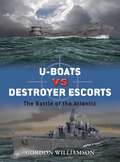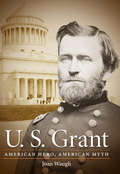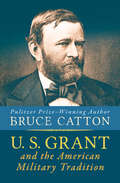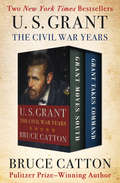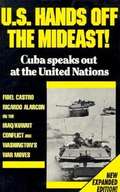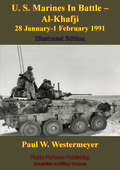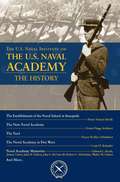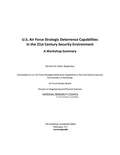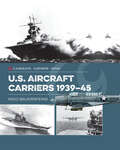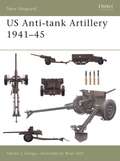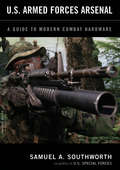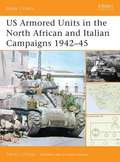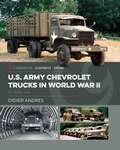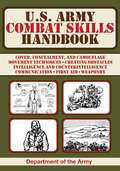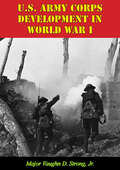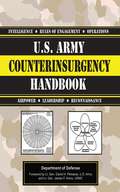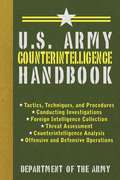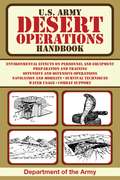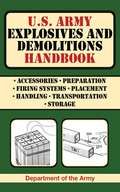- Table View
- List View
U-boats vs Destroyer Escorts
by Gordon WilliamsonWinston Churchill claimed that the "U-boat peril" was the only thing that ever frightened him during World War II. A formidable foe, the U-boat was developed from a small coastal vessel into a state-of-the-art killer, successfully stalking the high seas picking off merchant convoy ships. It was not until the destroyer escort was introduced, alongside the development of destroyer groups with dedicated anti-submarine tactics, that there was an effective means of defence and attack against the U-boat peril.Gordon Williamson describes the design and development of these two deadly opponents, their strengths and weaknesses and of their tactics, weaponry and training. He provides an insight into the lives of the Allied Navy and Wolf Pack crews as they played their deadly games of cat and mouse on the high seas, gambling not only with their lives but with the fate of their nations.
U. S. Dragoon: Experiences in the Mexican War 1846-48 and on the South Western Frontier
by Samuel E Chamberlain“From soldier to wagon master to scalp hunterChamberlain left Boston as a mere youth and joined the United States Army. He became a soldier in the 1st US Dragoons and determined to become the very ideal of the daring cavalryman both on and off the battlefields of the American-Mexican War. His is a tale—not a little tall—that includes accounts of passionate love affairs, duels to the death, pitched battles and exploits of daring in which Chamberlain himself features as the central heroic figure. Certainly he was a larger than life character, as his accounts of constant troubles with his superiors for brawling, drunkenness and insubordination appear with a detail and frequency which suggest authenticity. At the end of the war Chamberlain became a wagon master—possibly after deserting the army—and then threw himself into a series of adventures with a notorious band of scalp hunters led by the infamous John Glanton. A highly entertaining and informative account of the United States cavalry at war, in which many of the principal characters of the American Civil War—who appear within its pages—learned their craft.”-Print ed.
U. S. Grant
by Joan WaughAt the time of his death, Ulysses S. Grant was the most famous person in America, considered by most citizens to be equal in stature to George Washington and Abraham Lincoln. Yet today his monuments are rarely visited, his military reputation is overshadowed by that of Robert E. Lee, and his presidency is permanently mired at the bottom of historical rankings. In U. S. Grant, Joan Waugh investigates Grant's place in public memory and the reasons behind the rise and fall of his renown, while simultaneously underscoring the fluctuating memory of the Civil War itself.
U. S. Grant and the American Military Tradition
by Bruce CattonA fascinating and insightful examination of the life and times of the victorious Civil War general who became a controversial American president In U. S. Grant and the American Military Tradition, Pulitzer Prize-winning historian Bruce Catton explores the life and legacy of one of the nation's greatest and most misunderstood heroes, before, during, and after the terrible War Between the States that violently split the country in two. Beginning with Ulysses S. Grant's youth in Ohio and his service as a young lieutenant under General Zachary Taylor in the Mexican-American War, the story continues through Grant's post-war disgrace, his forced resignation for drinking, and his failures as a citizen farmer and salesman. But after the Civil War broke out, Grant rose from the rank of an unknown solider to commanding general of the US Army, finding redemption as the military savior of the embattled Union. Proving his reputation as America's premiere expert on the Civil War, Catton examines Grant's campaigns in enthralling detail, including Fort Henry; Shiloh; the Siege of Vicksburg, which set the Confederate enemy on the inevitable road to defeat; and Robert E. Lee's surrender at Appomattox Court House, which solidified Grant as a figure of national acclaim. Catton then explores Grant's two-term presidency and final years, casting an illuminating new light on a complex and controversial national figure whose great accomplishments have all too often been downplayed or overlooked.
U. S. Grant: Grant Moves South and Grant Takes Command
by Bruce CattonPulitzer Prize–winning historian Bruce Catton&’s acclaimed two-book biography of complex and controversial Union commander Ulysses S. Grant. In these two comprehensive and engaging volumes, preeminent Civil War historian Bruce Catton follows the wartime movements of Ulysses S. Grant, detailing the Union commander&’s bold tactics and his relentless dedication to achieving the North&’s victory in the nation&’s bloodiest conflict. While a succession of Union generals were losing battles and sacrificing troops due to ego, egregious errors, and incompetence in the early years of the war, an unassuming Federal army colonel was excelling in the Western theater of operations. Grant Moves South details how Grant, as commander of the Twenty-First Illinois Volunteer Infantry, though unskilled in military power politics and disregarded by his peers, was proving to be an unstoppable force. He won victory after victory at Belmont, Fort Henry, and Fort Donelson, while sagaciously avoiding near-catastrophe and ultimately triumphing at Shiloh. His decisive victory at Vicksburg would cost the Confederacy its invaluable lifeline: the Mississippi River. Grant Takes Command picks up in the summer of 1863 when President Abraham Lincoln promoted Grant to the head of the Army of the Potomac, placing nothing less than the future of an entire nation in the hands of the military leader. Grant&’s acute strategic thinking and unshakeable tenacity led to the crushing defeat of the Confederacy in the Overland Campaign in Virginia and the Siege of Petersburg. In the spring of 1865, Grant finally forced Robert E. Lee&’s surrender at Appomattox Court House, ending the brutal conflict. Although tragedy struck only days later when Lincoln was assassinated, Grant&’s triumphs on the battlefield ensured that the president&’s principles of unity and freedom would endure. Based in large part on military communiqués, personal eyewitness accounts, and Grant&’s own writings, this engrossing two-part biography offers readers an in-depth portrait of the extraordinary warrior and unparalleled strategist whose battlefield brilliance clinched the downfall of the Confederacy in the Civil War.
U. S. Hands Off the Mideast! Cuba Speaks Out at the United Nations
by Fidel Castro Ricardo Alarcón Mary-Alice WatersFailure to attain a political solution would be a defeat for humanity. For every life lost on the battlefields of the Arab Persian Gulf, a thousand persons will die of hunger in the Third World. Such a fate would be unavoidable. Fidel Castro. Is it really the need to promote respect for the independence, sovereignty, and territorial integrity of states that motivates the United States? Or is it the ambition of the United States to intervene and dominate the Middle East? Ricardo Alarcon. Since the onset of the crisis in the Middle East that began with Iraq's invasion of Kuwait, only one world power Cuba has consistently spoken out against Washington's accelerating war preparations in the region and the horrible consequences entailed for the great majority of humanity. This book contains the statements by Cuban Ambassador to the United Nations Ricardo Alarcon and President Fidel Castro as the crisis has unfolded, together with each of the resolutions approved by the UN Security Council. In their statements, the Cuban leaders rebut the pretexts and arguments used by Washington to justify its unilateral acts of aggression. This is indispensable reading for all those concerned about the U.S. government's march toward war.
U. S. Marines In Battle - Al-Khafji 28 January-1 February 1991 Operation Desert Storm [Illustrated Edition]
by Paul W. WestermeyerIncludes over 20 maps, diagrams and illustrations."The Battle of Khafji was the first major ground engagement of the Gulf War. It took place in and around the Saudi Arabian city of Khafji, from 29 January to 1 February 1991 and marked the culmination of the Coalition's air campaign over Kuwait and Iraq, which had begun on 17 January 1991.Iraqi leader Saddam Hussein, who had already tried and failed to draw Coalition troops into costly ground engagements by shelling Saudi positions and oil storage tanks and firing Scud surface-to-surface missiles at Israel, ordered the invasion of Saudi Arabia from southern Kuwait. The 1st and 5th Mechanized Divisions and 3rd Armored Division were ordered to conduct a multi-pronged invasion toward Khafji, engaging American, Saudi and Qatari forces along the coastline. These three divisions, which had been heavily damaged by Coalition aircraft in the preceding days, attacked on 29 January. Most of their attacks were repulsed by U.S. Marines as well as U.S. Army Rangers and Coalition aircraft, but one of the Iraqi columns occupied Khafji on the night of 29-30 January. Between 30 January and 1 February, two Saudi Arabian National Guard battalions and two Qatari tank companies attempted to retake control of the city, aided by Coalition aircraft and American artillery. By 1 February, the city had been recaptured at the cost of 43 Coalition servicemen dead and 52 wounded. Iraqi Army fatalities numbered between 60 and 300, while an estimated 400 were captured as prisoners of war.The battle serves as a modern demonstration that air power in a supporting role to ground forces can be of great assistance in halting and defeating a major ground operation. It was also a major test of the Saudi and Qatari armies. Although the capture of Khafji was a propaganda victory for the Ba'athist Iraqi government, its subsequent recapture by Saudi and Qatari ground forces provided a major morale boost for Coalition forces."-Wiki
U. S. Naval Academy
by Thomas J. CutlerThe U. S. Naval Institute Chronicles series focuses on the relevance of history by exploring topics like significant battles, personalities, and service components. Tapping into the U. S. Naval Institute's robust archives, these carefully selected volumes help readers understand nuanced subjects by providing unique perspectives and some of the best contributions that have helped shape naval thinking over the many decades since the Institute’s founding in 1873. This edition of Chronicles culls articles and excerpts from the vast library of the U. S. Naval Institute Proceedings to tell the story of the U. S. Naval Academy, training ground for the men and women who serve in the U. S. Navy.
U.S. Air Force Strategic Deterrence Capabilities in the 21st Century Security Environment
by Division On Engineering Physical SciencesChanges in the 21st century security environment require new analytic approaches to support strategic deterrence. Because current adversaries may be deterred from the use of nuclear weapons differently than were Cold War adversaries, the Air Force needs an analytic process and tools that can help determine those Air Force capabilities that will successfully deter or defeat these new nuclear-armed adversaries and assure U. S. allies. While some analytic tools are available, a coherent approach for their use in developing strategy and policy appears to be lacking. Without a coherent analytic approach that addresses the nuances of today's security environment, Air Force views of its strategic deterrence needs may not be understood or accepted by the appropriate decision makers. A coherent approach will support Air Force decisions about its strategic force priorities and needs, deter actual or potential adversaries, and assure U. S. allies. In this context, the Air Force in 2012 requested that the Air Force Studies Board of the National Research Council undertake a workshop to bring together national experts to discuss current challenges relating strategic deterrence and potential new tools and methods that the Air Force might leverage in its strategic deterrence mission. The workshop consisted of two 3-day sessions held in Washington, DC on September 26-28, 2012 and January 29-31, 2013 and was attended by a very diverse set of participants with expertise in strategic deterrence and a range of analytic tools of potential interest to the Air Force. U. S. Air Force Strategic Deterrence Capabilities in the 21st Century Security Environment summarizes this workshop.
U.S. Air Force Survival Handbook: The Portable And Essential Guide To Staying Alive (US Army Survival)
by United States Air ForceWritten for use in formal United States Air Force survival training courses, the U.S. Air Force Survival Handbook iis the bible for pilots who want to stay alive--no matter what. Assuming, as the Air Force does, that flight personnel may be faced at any time with a bailout or crash landing in hostile territory without supplies, the advice here is superlatively practical, but also surprisingly readable and interesting. Detailing specific survival threats at sea, in the tropics, in the desert, in Arctic conditions, and the psychological perils of imprisonment and torture, this handbook is replete with fascinating and useful (if unsettling) information. Precisely written, profusely illustrated, and completely authoritative, this is an essential book for anyone--soldier or civilian--looking for knowledge that could prove to be the difference between life and death in a dangerous situation.
U.S. Air Force Survival Handbook: The Portable And Essential Guide To Staying Alive (Us Army Survival Ser.)
by United States Air Force Jay McculloughDesigned for use in formal Air Force training, the U.S. Air Force Survival Handbook was written to help a pilot who finds him or herself in a hostile environment. For the more general reader, it offers a complete and comprehensive manual of outdoor survival techniques.It includes expert advice on: First aid for illness and injury Finding your way without a map Building a fire Finding food and water Using ropes and tying knots Concealment techniques Signaling for help Survival at sea Building shelters Animal tracking Predicting the weather And much moreBy outlining specific survival threats found at sea, in the desert, in mountain terrain, and in arctic conditions, and offering techniques on surviving them, this book, releasing on the seventieth anniversary of the U.S. Air Force, is invaluable to both the casual outdoorsman and the extreme sports enthusiast, as well as anyone looking for insight into the training tactics of the U.S. Air Force
U.S. Aircraft Carriers 1939–45 (Casemate Illustrated Special)
by Ingo BauernfeindA detailed and fully illustrated account of the development of American aircraft carriers up to and during World War II. This extensively illustrated volume tells the dramatic yet successful story of U.S. aircraft carriers in World War II by class, ranging from early pre-war designs to escort carriers built from destroyer hulls, to the gigantic fleet carriers serving as the predecessors of modern-day super carriers. Besides covering the famous great carrier battles in the Pacific, this book also tells of the equally important actions of U.S. flat tops hunting and destroying German U-boats in the Atlantic, making an enormous contribution to the elimination of the U-boat dangers and the safe arrival of transatlantic supplies, so desperately needed for the launch of D-Day. Including profiles and explanatory text boxes, the concise text gives a clear overview of each ship&’s career, its fate and its significance in American naval history. Moreover, the reader learns about the technical evolution of U.S. carriers throughout the war, and the various aircraft launched from these magnificent vessels to engage their Japanese or German foes. This volume provides an overview of preserved World War II flat tops serving as floating museums for future generations as well as a dive to the sunken U.S.S. Saratoga at Bikini Atoll.Praise for U.S. Aircraft Carriers 1939–45 &“Bauernfeind brings to the reader a fitting conclusion to a superb historical portrait of these capital warships that carried naval aviation to victory in World War II. This is an exemplary work and is recommended as an introductory reference for readers not already steeped in World War II ship history.&” —Air Power History &“The coverage of the CVEs and CVLs, coupled with the book&’s first-rate graphics, profuse and precisely captioned photographs, well-written text, and reasonable price make it a very good choice for readers looking for an overview of U.S. carriers in World War II.&” —Naval Historical Foundation
U.S. Anti-tank Artillery, 1941-45
by Steven J. ZalogaThe 37mm anti-tank gun developed by the U.S. army becoming obsolete, the U.S. began the licensed manufacture of the British 6-pdr. Further anti-tank measures and weapons designed specifically for use by the Tank Destroyer Force were developed.
U.S. Armed Forces Arsenal: A Guide to Modern Combat Hardware
by Samuel A. SouthworthA handy guide to the fearsome hi-tech weapons and modern equipment of today's American forces
U.S. Armored Units in the North African and Italian Campaigns, 1942-45
by Steven J. ZalogaDetails the evolution of U.S. armoured warfare tactics and doctrine, learned from the difficult experiences of North Africa, and illustrates how they were used elsewhere in the MTO, particularly in the Italian Peninsula.
U.S. Army Ambulances & Medical Vehicles in World War II (Casemate Illustrated Special)
by Didier AndresA “cool compendium” of photos and information about the vehicles that helped save American troops’ lives (Cybermodeler).Of all the armies involved in World War II, the U.S. Army developed the most sophisticated system for the transport and treatment of injured and sick soldiers, pushing the boundaries of available technology to give their men the best chance of not only survival but a full recovery.Each infantry regiment had a medical detachment tasked with conserving the strength of the regiment by not only providing medical and dental treatment but also undertaking all possible measures to keep the regiment healthy. In combat they would provide emergency medical treatment on the battlefield, then move casualties to aid stations they had established. At aid stations, casualties would be triaged, stabilized, and treated before being moved on for further treatment. Vehicles formed a crucial part of the Medical Detachment’s equipment.This fully illustrated, comprehensive book covers all types of medical vehicles used both in-theater and in the United States, including ambulances and technical support vehicles. It details vehicle markings modifications, for use in the evacuation of troops from the battlefield, and the other uses these vehicles were adapted for during the war—including their use as “Clubmobiles” and “Chuck Wagons” by the American Red Cross.
U.S. Army Chevrolet Trucks in World War II (Casemate Illustrated Special)
by Didier AndresA detailed, pictorial history of the 1 1/2-ton Chevy truck and its use by the U.S. Army during World War II.From 1940 to 1945, large numbers of trucks of all categories were delivered to the U.S. Army by the Chevrolet Motor Division of General Motors. Over 160,000 of these trucks were G-506 light four-wheel-drive trucks—which became the standard 1 1/2-ton, 4x4 truck for both the U.S. Army and Army Air Corps during the war. In addition, many more thousands were delivered to Allied forces as part of the Lend-Lease program, including nearly 50,000 delivered to the Soviet Union. Tough, well-built, and more agile than the deuce and a half, the Chevy 1½ ton played a part in every theater of operations during the war. Its durability and mechanical reliability made it ideal for a wide range of missions. Not for nothing did Chevy advertise the trucks during the war as “Vehicles of Victory.”More than 75 years after it was designed, the small Chevrolet truck is still a favorite with collectors. This fully illustrated book details the different series of trucks and their many uses within the U.S. Army including cargo trucks, panel delivery trucks for the Signal Corps, dump trucks for engineers, telephone trucks, tractors, and bomb service trucks for the air force. It also covers their part in the Lend-Lease program, and their continued use after the war.
U.S. Army Combat Pistol Training Handbook (US Army Survival)
by ArmyThis handbook is perfect for those interested in joining the army as well as for those who merely want to learn how to shoot combat pistols. The U.S. Army Combat Pistol Training Handbook (FM 3-23.35) reflects current Army standards in weapons qualification and can be a guide for the instructor to develop training programs, plans, and lessons that meet the objectives of the U.S. Army Marksmanship program for developing combat effective marksmen.The first part focuses on the components and functions of the pistols, where readers will learn about components, ammunition, maintenance and assembly, clearing procedures, preventive maintenance, operation, loading, unloading and clearing, troubleshooting, and much more. The second part is where things get fun and where readers will find instructions on topics such as basic marksmanship, grip and aiming, breath control, trigger squeeze, techniques of firing, target engagement, combat reloading techniques, coaching, and safety, among others. Finally, the appendixes include a thorough explanation of the U.S. Army qualification courses and training schedules.This compact guide will tell you everything you need to know about training with an M9 or M11 pistol. Loaded with illustrations and charts, this handbook shows as well as tells how to be the best pistol shooter in the Army.
U.S. Army Combat Skills Handbook (US Army Survival)
by ArmyRecognizing that “wars are not won by machines and weapons but by the soldiers who use them,” this comprehensive manual not only informs the reader of the timeless skills necessary to survive on the battlefield, but also instructs the soldier on how to perform and execute these tasks to succeed in combat. From concealment and mobility to first aid and personal care, you too can possess the knowledge armed service people are equipped with so they can do their jobs properly and confidently. This informative and exhaustive guide draws upon the real-life experiences of soldiers who have faced warfare and lived in combat zones. Practical and explicit instructions on team formation, proper positioning for offensive and defensive maneuvers, and handling of equipment and weaponry are thoroughly explained. Also included is advice on life-saving CPR and wound-care techniques; sections on combat intelligence and nuclear, biological, and chemical warfare; and appendices covering mines, demolitions, obstacles, combat in urban areas, tracking, and evasion and escape. Illustrations throughout the book depict various field scenarios that soldiers face in a war zone. See what it takes to perform, inspire, and lead in the U.S. Army!
U.S. Army Corps Development In World War I
by Major Vaughn D. Strong Jr.This paper examines the development of the American Army corps structure during World War I. The corps formation developed in World War I by General John J. Pershing was the culmination of 56 years of lessons learned from the Civil War through the beginning of World War I. The success of the American Expeditionary force (AEF) in World War I was, in large part, the result of the development and combat effectiveness of the corps formation. The corps formation allowed commanders flexibility, concentrated firepower, sustainability, and increased command and control.The American corps formation in World War I led the AEF to victory in the Saint Mihiel and Meuse-Argonne campaigns. The American corps formation provided resources and capabilities that helped provide the needed edge to defeat the Central Powers and help end World War I.
U.S. Army Counterinsurgency Handbook (US Army Survival)
by David H. Petraeus James F. Amos ArmyAnyone with an interest in what our troops are doing overseas will find this government manual an excellent source of information. It gives a detailed breakdown of what an insurgency is, how one starts and builds, and what our forces must do to overcome it. Find out the key roles often taken by insurgents; how to carry out intelligence, surveillance, and reconnaissance missions; and what ethical questions arise in handling these types of situations. Historical examples and anecdotes of both successes and failures provide an overall perspective. Dozens of illustrations and charts break down the information for civilians, and appendices cover legal issues, translation difficulties, airpower, and more.
U.S. Army Counterintelligence Handbook (Us Army Survival Ser.)
by Department of the ArmyThe life of a counterintelligence (CI) operative has been immortalized in film and novels as being filled with glamour and excitement. While international travel, heroism, and danger are all part of the job description, the fundamentals of counterintelligence are discipline, skill, and—well—intelligence. CI operations include conducting investigations, offensive and defensive operations, security and vulnerability analyses, and intelligence collection in peace and at all levels of conflict to support command needs. This guide serves to inform commanders, agents, and analysts on how to identify, neutralize, and exploit any foreign attempts to conduct operations against the U.S. Army. Find out how CI operatives combat terrorism, create battlefield deception, and inform all echelons of combat of both real and potential threats from the U.S. Army's own guide to counterintelligence. The tactics, techniques, and procedures (TTP) outlined are the same instructions that CI personnel follow in the field. As the world becomes more interconnected and as technological advances continue to be made, proper CI techniques are exceedingly critical to the protection of the U.S. Army. Counterintelligence is not just the subject for an entertaining story, it is how peacekeeping, humanitarian, and counter-drug operations are carried out in this globalized world.
U.S. Army Desert Operations Handbook (US Army Survival)
by ArmyImagine working all day in 100-degree plus temperatures under constant life-threatening circumstances, sometimes relying only on the negligible amount of hydration from a cactus you’ve dug up. This is the life of a U.S. Army soldier in places like Iraq, Afghanistan, and elsewhere, which is why the U.S. Army Desert Operations Handbook is a vital reference for survival in one of the harshest environments in the world. This official guide covers how to plan and conduct operations, how the environment affects personnel and equipment, and most importantly, how to survive and receive supplies in the desert. The obvious problems with extreme temperatures are water location and mobility. However, from handling and caring for firearms to operating and fueling a tank, the entire game changes in the dry, sandy desert conditions. The skills in this guide are taken from lessons learned in real combat situations. Success in desert operations requires the ability to adapt with constant terrain and temperature changes, which are often drastic within the same twenty-four–hour period. All the while, the soldier must be able to move within a unit without being visible to unfriendly groups. This combat-tested manual is sure to arm anyone with the skills necessary to survive in the desert.
U.S. Army Diamond T Vehicles in World War II (Casemate Illustrated Special #Ciss0012)
by Didier AndresA detailed summary of all types of Diamond T vehicles used by the U.S. Army during World War II, packed full of period photos and diagrams.Between 1940 and 1945, Diamond T Motor Car Company supplied just over 50,000 vehicles to the U.S. military, and also to the Allies. Of this, just over 30,000 were heavy 4-ton 6x6 trucks of varying types: cargo, tow truck, pontoon carrier, engineer, cartographic, etc. The “Diamond” would serve in all theaters of operations, wherever its robustness and reliability were necessary to complete the mission. Due to its expertise, Diamond T also produced the famous half-track, with more than 10,000 manufactured. All these models are described in this work by Didier Andres, an expert in the subject. The text is illustrated throughout using archival and period photographs and diagrams.Praise for U.S. Army Diamond T Vehicles in World War II“Another excellent collaboration of the Casemate Illustrated Specials with the author Didier Andres and a great tribute to this legendary vehicle. A worthy addition to any personal library whether it belongs to an historian, a vehicle restorer, or a builder of military miniatures. This volume is highly recommended without reservation.” —War Wheels“This comprehensive and fully illustrated account describes in technical detail the evolution of the Diamond T design and all the Diamond T models produced for the Army during World War II . . . Highly recommended for beginner to advanced builders.” —AMPS
U.S. Army Explosives and Demolitions Handbook (US Army Survival)
by ArmyMilitary demolitions are the destruction by fire, water, explosive, and mechanical means of areas, structures, facilities, or materials to accomplish a military objective. The U.S. Army Explosives and Demolitions Handbook is a guide to the use of explosives in the destruction of military obstacles from the Department of the U.S. Army. This guide includes information on types, characteristics, and uses of explosives and auxiliary equipment; preparation, placement, and firing of charges; safety precautions; handling, transportation, and storage of explosives; deliberate and hasty demolition methods; and much more. Applicable to nuclear and nonnuclear warfare, and having offensive and defensive uses, the knowledge one will come away with from reading this handbook is invaluable.
